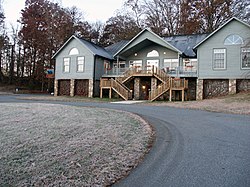John C. Campbell Folk School
|
John C. Campbell Folk School Historic District
|
|

Dining Hall
|
|
| Location | Off U.S. Route 64, Brasstown, North Carolina |
|---|---|
| Coordinates | 35°02′14″N 83°57′52″W / 35.0372°N 83.9645°WCoordinates: 35°02′14″N 83°57′52″W / 35.0372°N 83.9645°W |
| Built | 1925 |
| Architect | Multiple |
| NRHP Reference # | 83001839 |
| Added to NRHP | August 22, 1983 |
The John C. Campbell Folk School, also referred to as "The Folk School" is located near Brasstown, North Carolina along the Cherokee County and Clay line. The school was founded to nurture and preserve the folk arts of the Appalachian Mountains, it is a non-profit adult educational organization based on non-competitive learning. Founded in 1925, the Folk School's motto is “I sing behind the plow”.
It was listed on the National Register of Historic Places as a national historic district in 1983. The district encompasses 19 contributing buildings. Notable buildings include the Farm House (pre-1925), Keith House (1926-1928), Log House Museum (19th century, 1926), Mill House (1928), (Former) Milking Barn (now Pittman Blacksmith Shop, c. 1930), Hay Barn (1931), Tower House (1933), Rock House (c. 1932), and Hill House (c. 1932).
The Folk School has week-long and weekend classes year-round in traditional and contemporary arts, including blacksmithing, music, dance, cooking, gardening, nature studies, photography, storytelling and writing. The school campus includes a history museum, craft shop, nature trails, lodging, campground and cafeteria. The school also holds a regular concert series and community dances. The School hosts Morris Dance, Garland Dance and Clogging Teams.
After spending eighteen months traveling between Denmark, Norway, Sweden, and Finland, visiting local schools along the way, Olive Dame Campbell and her colleague Marguerite Butler, began forming the John C. Campbell Folk School in 1925 in Brasstown, North Carolina. This folk high school or folkehøjskole, was dedicated to her late husband, John C. Campbell and was based on the Danish Folk School style of non competitive education, where no grades were given. Instead, students and teachers formed a community that worked together to help each other advance in various crafts such as blacksmithing.
...
Wikipedia


